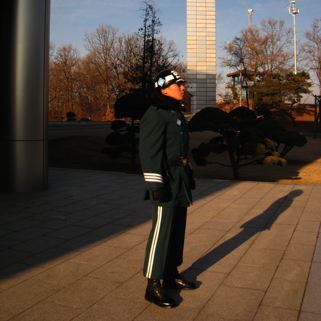 Most visitors who travel to South Korea will run through a list of required tourist attractions: temples, monuments and karaoke bars. But the more curious ones will also add a very special day trip to their itinerary—one that is a stark reminder that in at least one part of the world, a cold war still exists.
Most visitors who travel to South Korea will run through a list of required tourist attractions: temples, monuments and karaoke bars. But the more curious ones will also add a very special day trip to their itinerary—one that is a stark reminder that in at least one part of the world, a cold war still exists.
Karl I. Muller reports on his observations from the Demilitarized Zone at the border of North and South Korea.
A soldier stands tall, stern, and unmoving, his body half covered by a nearby wall, so in the event of enemy fire, he is partially shielded.
Only a few feet from him, enemy soldiers stand as well, patrolling at regular intervals. The situation is tense, and each side is ready to aggressively react at the slightest movement.
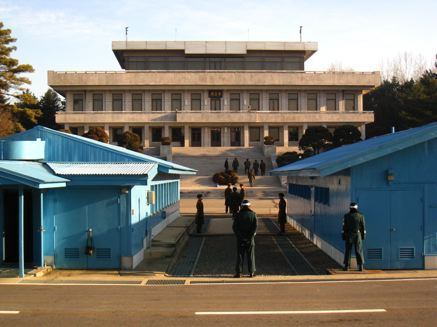 What might seem like a description of an establishing shot in a script for a military film is actually the real-life situation at the Joint Security Area (JSA) in Panmunjom, the small village that lies at the Demilitarized Zone (DMZ) between the South Korean and North Korean border.
What might seem like a description of an establishing shot in a script for a military film is actually the real-life situation at the Joint Security Area (JSA) in Panmunjom, the small village that lies at the Demilitarized Zone (DMZ) between the South Korean and North Korean border.
At the end of the Korean War in 1953, North Korea and South Korea agreed to a ceasefire and signed an armistice that created a 2.5-mile wide and 155-mile long neutral area between the two nations. However, the armistice was never followed by a peace treaty, thus both countries are technically still at war with one another.
The only way for tourists to reach Panmunjom, the JSA, and literally place yourself in North Korea is through guided tours. One option is the USO tour which departs from Seoul and includes a guided tour of Panmunjom, the JSA, and the Third Tunnel.
Don’t miss Karl I. Muller’s Off the Brochure Travel Guide to Seoul, South Korea.
Even before departing, it’s clear that there is nothing light about this situation. The USO tour requires a strict dress code, which includes no frayed jeans, flip flops, tank tops, oversized clothing, sheer outer layers, or any unofficial military items that are not part of prescribed duty. Anyone who doesn’t adhere to these rules is turned away.
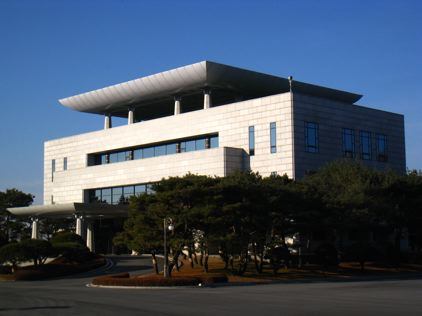 The tour begins at 8 a.m. with the guide, UN Command Military soldier, laying out the rules: Photographs are only permitted at designated points; participants must form lines immediately upon request; and always show the utmost respect for the soldiers at the JSA.
The tour begins at 8 a.m. with the guide, UN Command Military soldier, laying out the rules: Photographs are only permitted at designated points; participants must form lines immediately upon request; and always show the utmost respect for the soldiers at the JSA.
There is no room for interpretation.
With the DMZ only about 35 miles outside of Seoul, the bus ride is not particularly long, but the checkpoints and scenery are a constant reminder of the gravity of the situation. Heading north, the fencing lining the riverbank seems to develop barbed wire, sharply contrasting with the otherwise serene picture of the waves lapping at the banks.
After going through a few checkpoints, the bus arrives at the JSA, an area managed by the United Nations.
For Korean-style experiences closer to home, check out America’s Gypsy: Koreatown, Los Angeles.
The first stop is Ballinger Hall to watch a presentation about the DMZ that includes a video on its history, North-South Korean relations, and, again, instructions to only take photos when permitted.
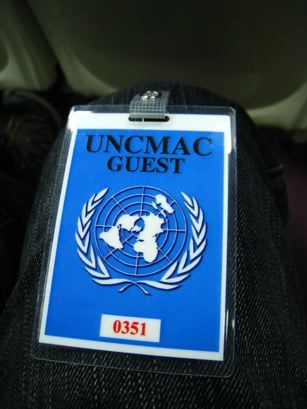 Guests are required to sign waivers that, in the event of an altercation during our visit, neither the UN nor the South Korean government would be liable for any harm or damage. Blue guest badges designate the group as UN guests, with instructions that it is to be worn at all times above the waist.
Guests are required to sign waivers that, in the event of an altercation during our visit, neither the UN nor the South Korean government would be liable for any harm or damage. Blue guest badges designate the group as UN guests, with instructions that it is to be worn at all times above the waist.
It feels as if we are being prepared to enter war.
The next stop is the Military Demarcation Line. Upon arrival at the House of Peace, a building used for North-South Korea exchanges, we are fortunate enough to catch an unexpected sight: the North Korean ritual of the changing of the guards.
Although the guide continues on with his explanation about Korean history, the stern and precise movement of the North Korean soldiers dominate the scene. In what is already a stark and humorless environment, the tension seems to be heightened by the activity on the bleak North Korean side.
For a brief moment, the rituals are reminiscent of the Buckingham Palace Guards—but in there, one expects to see tourists trying to get the guards to break stride or crack a smile. Here, these guards are literally standing toe-to-toe at the front lines of enemy battle. Provoking them would be a fool’s choice.
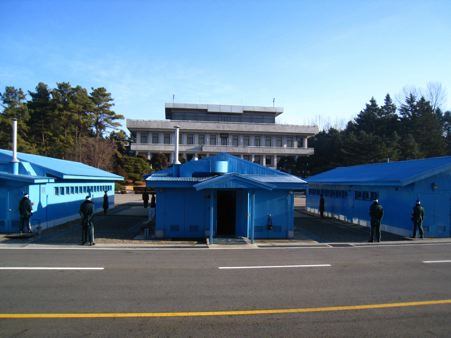 The JSA consists of several blue buildings, some of which straddle the border between North and South Korea. In fact, it is where most talks between the two countries occur.
The JSA consists of several blue buildings, some of which straddle the border between North and South Korea. In fact, it is where most talks between the two countries occur.
Inside one of these buildings is the Military Demarcation Line (MDL)—an imaginary line that literally runs through a large rectangular conference table situated in the building. In fact, those visitors standing on the far side of the conference table are effectively in North Korea.
Though the mood is still serious, there’s something about the MDL that conjures up images of squabbling siblings who might draw an imaginary line down their bedroom. But again, this is serious business: If anyone were to step over the line outside the building or exit through the door that lies in North Korea, it would be considered a movement towards defection to the North.
Looking for a more relaxing time when visiting South Korea? Try Suzy Gershman’s Postcard from Seoul, South Korea for information on everything from local brands to hotels to airports.
 The next stop is the Third Tunnel. Discovered by South Korea in 1978, the tunnel is large enough in size to mobilize an entire division of North Korean troops within an hour. It is a glaring reminder of how the two countries are constantly poised at the edge of conflict.
The next stop is the Third Tunnel. Discovered by South Korea in 1978, the tunnel is large enough in size to mobilize an entire division of North Korean troops within an hour. It is a glaring reminder of how the two countries are constantly poised at the edge of conflict.
However, despite evidence to the contrary, such as dynamite markings pointing toward South Korea, North Korea denies ever digging the tunnels (yes, there are multiple), even going so far as to accuse South Korea of digging them. No pictures are allowed here, but we are able to travel down the tunnel up until the MDL, with three concrete walls blocking us from going further.
While a trip to the DMZ is worth a lifetime of bragging rights, I find that I have no urge to stay any longer than the tour allowed. The tension is palpable at all times, and the threat of an altercation between the two sides is omnipresent. When it’s time to depart the DMZ, I’m happy to climb back onboard the bus and return to Seoul.
A USO tour (https://affiliates.uso.org/) runs out of Seoul and costs about $40 (lunch not included). Bring your passport and adhere to the dress code or you will be turned away.
By Karl I. Muller for PeterGreenberg.com.
For more on travel to South Korea or North Korea, visit our North & South Korea section.
Looking for more intense, once-in-a-lifetime travel experiences? Check out Tough Travel Hot Spots on the CBS Early Show.
And even more travel experiences like this can be found in this excerpt from Peter’s Travel Detective Bible on Tough Travels.












